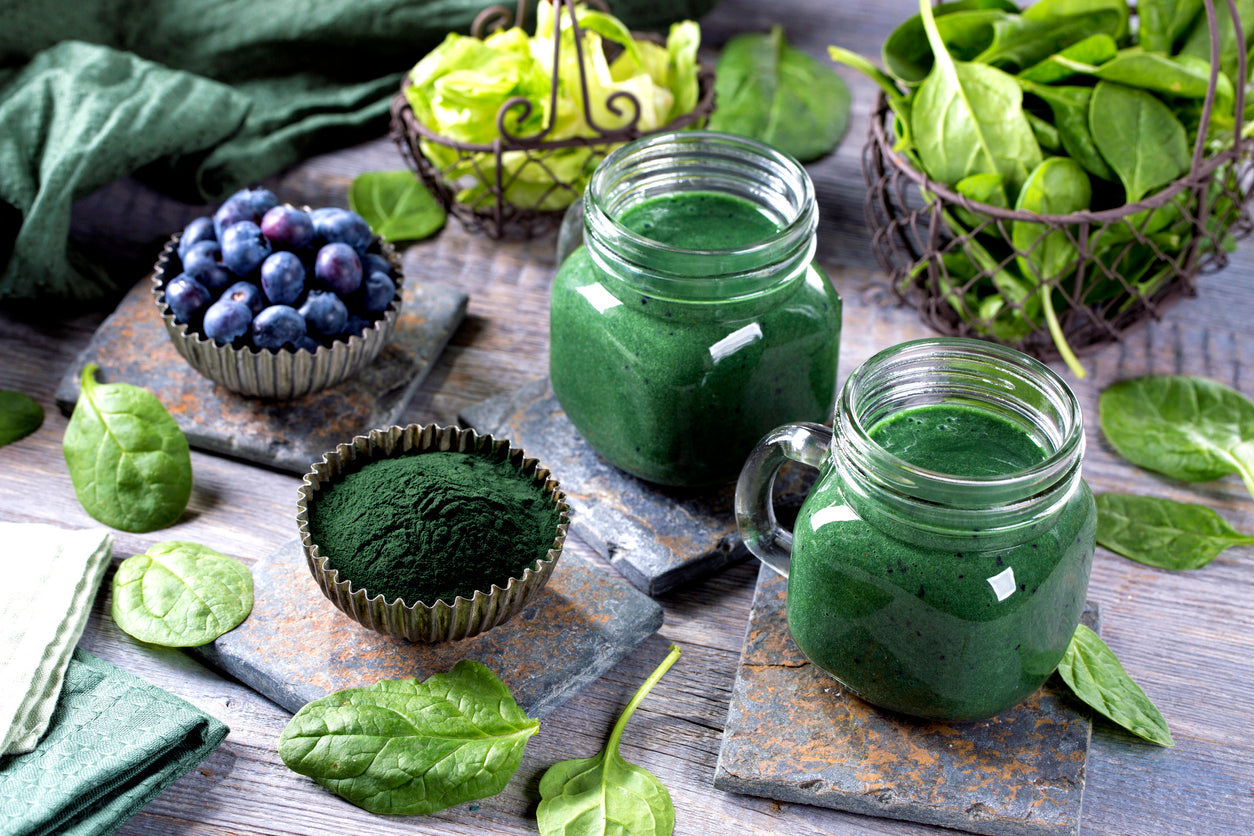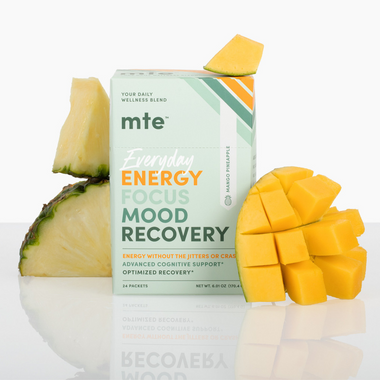
Diary of a Superfood: Understanding Spirulina
One of the most well-known superfoods, spirulina is a popular addition to green supplement powders, drinks, capsules, and more. A blue-green algae, it’s technically a conglomerated biomass of cyanobacteria. Of the three species that occur in nature, the one that’s utilized in foods today is called Arthrospira platensis.
We’re going to keep calling it spirulina.
It’s easy (and smart!) to be skeptical of health-food trends. Many times, a couple celebrity endorsements make something famous before there’s any determination as to whether the claimed benefits really even exist. Fortunately, spirulina has got a long track record with an equally-long list of receipts.
From Primordial Soup to Space Travel: History of Spirulina
Spirulina has existed for nearly as long as any life on the planet has, with estimates its cyanobacteria ancestors emerged about 3.5 billion years ago. For context, it’s estimated the first microbes emerged only 3.7 billion years ago. As a primordial cyanobacteria, spirulina was a progenitor to many different kinds of life – algae, lichen, moss, amoeba, vertebrates – literally people.
Spirulina, as a biological entity, is a true OG, which already provides context into its usefulness as a dietary supplement. If it has such a foundational and intimate relationship with all life on earth, it makes sense it’d be a useful tool in human biology.
Spirulina as a food resource is a little more recent. Well, a lot more recent. It originated in what is modern-day Mexico (Lake Texcoco) and North-Central Africa (Lake Chad). The first technical documentation of spirulina use in the human diet is the Aztecs in the 16th century, who made pies out of the algae. It was also traditionally used by the Kanembu people in Chad, who also ate it as a pie/cake.
In the 1970s, the first botanical research on spirulina began in earnest in Mexico, with the first large-scale production of spirulina emerging before the decade was out. Spirulina can grow anywhere under the right conditions and is produced across the world today. Because it offers essentially complete nutrition, it’s also a staple at NASA as a supplement for astronauts.
The Makings of a Superfood: Nutritional Profile of Spirulina
As a building block of all life on earth – no exaggeration – spirulina is renowned for its high and bioavailable protein content. In dry weight, spirulina is up 60%-77% high-quality protein, with a biological value of 75% and 83% digestibility. It’s also well-balanced, with 9%-15% lipid content and 10%-17% carbohydrate content.
But that’s nowhere near the end as far as the potent compounds in this beyond-ancient blue-green algae. Part of spirulina’s protein content is a protein-bound pigment called C-Phycocyanin, which has demonstrated antioxidant, anticancer, anti-inflammatory, and immune-boosting abilities.
Spirulina also contains essential fatty acids that support everything from muscle function to nerve health and DNA integrity. Specifically, it includes immulina, a bioactive carbohydrate known to stimulate the immune system.
This seaweedy superfood also boasts a host of hard-to-find, super-important minerals, including:
- Iron
- Calcium
- Magnesium
- Zinc
- Manganese
- Copper
- β-carotene
- Chlorophyll
- Zeaxanthin
- B12
What Are the Benefits of Spirulina?
The fact that spirulina is stuffed to the gills with all these important biological resources means that it’s got quite a few benefits to offer. Better, we understand the hows and whys, and even better, we’ve got clinical evidence to demonstrate its effects.
Spirulina Promotes Thermogenesis
Beyond promoting natural energy production, this superfood might also be able to supercharge your metabolism. Recent research on spirulina applied to metabolism indicate its nutritional profile prevents fat accumulation, storage, weight gain, and the production of new fat cells by activating thermogenic processes. It’s also shown to make HIIT workouts more effective.
Spirulina Supports Immunity
It is well documented that spirulina inhibits the release of inflammatory chemicals, which results in anti-inflammatory effects. In clinical settings, spirulina supplements showed beneficial effects in people with allergic rhinitis, increased mucosal immunity, protected cell health, and reduced experienced severity of seasonal allergies.
The complete nutrition of spirulina provides the body essential resources needed for innate immune function. As well, the active compounds in spirulina have demonstrated antioxidant and free radical scavenging behavior.
Spirulina Promotes Healthy Cholesterol
High cholesterol is one of the biggest risk factors for heart disease, and heart disease is one of the most common causes of death in the US. Spirulina supplements have demonstrated an ability to raise LDL levels (the good cholesterol) without raising HDL levels (the bad cholesterol). It has also demonstrated an ability to reduced plaque formation in the arteries.
Spirulina Protects Against Cancer
Spirulina has shown antitumor activity in clinical settings, thought to largely be a product of its antioxidant and immunomodulating benefits. A study on topical and oral supplementation with spirulina over one year saw 45% of participants see complete regression in leukoplakia. It is unclear which compounds/mechanisms were responsible for this.
Spirulina Treats Arsenic Poisoning?
Chronic arsenic poisoning isn’t an issue in the US, but in other parts of the world, like Chile, Taiwan and India, arsenic levels in the drinking water leave entire populations at risk of chronic arsenic poisoning. Interestingly enough, a recent study on spirulina and zinc supplements showed that 16 weeks of consumption reduced arsenic levels more than baseline reduction in the control group.
Superfood Safety: Guidelines for Spirulina Supplements
The general rule of thumb is that yes, spirulina is safe, even at high doses. However, because of its complex nutritional profile and high level of bioactivity, spirulina may not be the right choice for everyone. Some things to consider before adding spirulina to your daily supplement routine:
- The safety of spirulina has not been determined in people who are pregnant/breastfeeding.
- Spirulina may exacerbate symptoms of some autoimmune disorders.
- It may interfere with blood clotting.
- Spirulina should not be taken by people with phenylketonuria (PKU).
- Certain medications may have adverse interactions with spirulina.
The real issue of safety, when it comes to buying spirulina supplements, is the reputability of the manufacturer. Pure, high-quality spirulina isn’t going to give you problems. However, less reputable companies may sell spirulina with fillers, contaminants, chemicals, or other dangerous, hidden stuff. It’s important to know the spirulina you’re taking is clean.
MTE: Healthy Energy from Adaptogens, Nootropics & Superfoods
With natural, clean, sustainably-sourced ingredients, the spirulina in MTE’s formulation is free of any sketchy stuff. And so is the whole formulation. A one-of-its-kind of 11 adaptogens, nootropics and superfoods, all the ingredients in MTE are naturally-sourced bioactive compounds that support overall wellness.
MTE promotes sustainable energy, tranquil mood, zoned-in focus, supports recovery at night, promotes immunity and anti-inflammatory activity, and supports healthy stress responses. Oh, and metabolism. And gut health.
With natural, sustainable energy sources like spirulina and paraxanthine, we don’t have to rely on the here-then-gone caffeine and sugar of traditional energy drinks. MTE is a healthy alternative to all-things-caffeine: energy drinks, coffee, tea – you name it.
Curious to learn more? Check it out.






